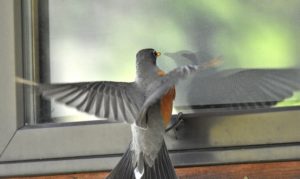
Flight is a magnificent means of transportation, but not without its dangers—especially for birds. For many birds, a journey across the skies ends with a deadly collision with windows, vehicles, cell towers or high-tension wires.
If you’ve been startled by the dull thud of a bird smacking your window, you’re not alone. Bird collisions with windows occur day and night, in all seasons, and in cities, suburbs and rural areas. Birds don’t see the glass, generally because it mirrors trees, shrubs, or sky, so the transparent panes appear to offer a passageway through a building.
It’s surprising how common this problem is. The National Fish and Wildlife Foundation and the U.S. Fish and Wildlife Service estimate that billions of birds die from aerial collisions each year in the U.S. And a lot of them, it seems, are colliding with our windows. Replacing glass or just cleaning it after a bird crash is a maintenance issue for the owner but can have catastrophic results for the bird.
Fortunately, some simple solutions can help protect our windows and the birds.
- Acopian Bird Savers. Also known as “zen curtains,” these closely spaced ropes hang down over windows. They do the work of tape or decals but are easier to install and can be aesthetically pleasing. You can order them to fit your windows or make your own. Make sure to get ARB approval.
- Screens. Installing mosquito screens over your windows is very effective, as long as they are on the outside of the window and cover the entire surface. I find the birds are hitting three windows in the back of the house that have no screening, all my screened windows have had no issues.
New Homes And Remodels
- Install external shutters and keep them closed when you’re not in the room or taking advantage of the light or view. (These can be huge energy savers, too!)
- Install external sun shades or awnings on windows, to block the reflection of sunlight. Remote controlled shades are available.
- On new construction or when putting in new windows, consider windows that have the screen on the entire outside of the glass.
- Add interior vertical blinds and keep the slats only half open.
- Avoid visual paths to sky and greenery. Bright windows on the opposite wall from your picture window may give the illusion of an open path to the other side. Closing a window shade or a door between rooms can sometimes solve this situation.
I hope this helps with some of the impact we have on our natural environment. If you plan to install or change your view, please make sure to ask the ARB before doing so, in order to get your approval first.
Laura Goguet
Community Manager